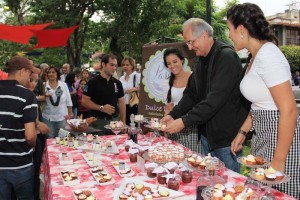In August 2013, around 20 small business owners meet late afternoon in a quiet street of Caracas to sell their products to pedestrians for a few hours. To anyone that has a minimum understanding of the violence and insecurity problem in the Venezuelan capital, hanging out in a quiet street at night sounds not only dangerous, but also reckless. Certainly, they had their doubts about doing it when representatives of the local government of Sucre, one of the biggest and most economically diverse municipalities of Caracas, approached them and proposed them to start “Jueves de Bulevar”.

“Jueves de Bulevar” is a bi-monthly event, which takes place every other Thursday in the main avenue of La Carlota, a quiet residential area, with houses, restaurants and La Casona (the official presidential residence). Although the proximity to the official presidential residence, the area hasn’t been spare by crime, and the quietness at night is a result of neighbors locking themselves in their houses after dark due to fear. Although it may have sounded reckless at first, after guarantying security measures for the businesses and costumers, the event took place for the first time and it was successful. Today, after two years, it still takes place in the same avenue with more businesses and more costumers. The main avenue of La Carlota has been reclaimed by its residents, at least every other Thursday.
As Latin Americans get richer, their cities get more violent and insecure. Caracas, in particular, shows worrisome insecurity and violence numbers. Interestingly, in both better and worst financial situations, violence has only increased. The population of the city has increased at a lower rate than in previous decades, with a 0.6% growth rate from 2001 to 2011[1]; and the country in general has received almost $4 billion in oil revenues over the past few years[2]. Today, the Venezuelan capital is the second most dangerous city in the world, second to San Pedro Sula in Honduras[3], which is haunted by drug cartels and the violence drug trafficking entails.
Wealth is often understood as an indicator of safety; when the general wealth of the population of a city increases, insecurity decreases. However, wealth = safety is no an irrefutable formula; although increased wealth is part of the indicators of a safer community, there many other factors that influence this phenomenon. World Bank data shows that today almost one third of the population is considered middle class, which represent an accelerated increase of 50% in the past 10 years[4]. Nonetheless, insecurity still is one of the main problems Latin American households face. In the region, wealth also equals migration to the cities, as 80% of the population is located in urban areas[5]. The rapid increased of the urban population, accompanied by the poor planning of the cities to growth at the same pace, have resulted in clustered urban centers, with insufficient services for residents, and a hotel-like lifestyle; one where people don’t interact with their neighbors because there are no physical spaces to do so and because they are afraid to be outside. Thus, there is no social capital and no common interests for protecting that capital.
There are many factors that feed violence and insecurity, the World Bank identified three categories of risk factors[6] that would increase the probabilities of an individual engaging in violence and crime in Latin America: individual, micro (family and community), and macro/structural factors. The macro/structural factors refer to institutions, structural inequality, social norms, demographic, and urban organization of the area. Local governments are in the position of tackling the problem of violence and insecurity when considering micro and macro risk factors. Some of these solutions require a long-term strategy, for example, improving the judicial and prison system, and others can be addressed with smaller investments and immediate actions, such as fixing the lighting on the streets. Nonetheless, there is a very important characteristic that is common to violent communities across the region; the relationship people have with their city and their neighbors, which if improved, can create social capital that can function as a preventive factor for violence and criminality.
Although indisputably overwhelming, violence and insecurity in Caracas can be tackled at the community level with a joint effort of the local government and the constituents. “Jueves de Bulevar” is a proof of that hypothesis; the rampant crime in Caracas continues to be worrisome, but every other Thursday is less of a problem for a few hours in the main street of La Carlota, in Caracas. This event is not an innovative idea for the region; there are many examples of local governments promoting life outside to increase social capital and tackle violence and insecurity, with significant success. In Buenos Aires, there is the Long Night of Museums[7], in Mexico City, there are night bike rides around the Bosques de Chapultepec[8], and many Latin American cities have a save and vibrant nightlife.
Caracas should not be the exception to the rule in the improvement of the cities of the region regarding safety and cultural activities at night. There needs to be collaboration between local governments and with the central government to tackle this issue. However, the role of the individual is key to prevent insecurity, if the prevention is increased through ameliorating the relationship every individual has with the city he or she lives in and with their neighbors, their cities will become safer, and more fun to live in.
[1]http://www.ine.gov.ve/documentos/Demografia/CensodePoblacionyVivienda/pdf/ResultadosBasicosCenso2011.pdf
[2] http://www.forbes.com/sites/afontevecchia/2015/03/05/venezuela-on-the-brink-maduro-arrests-caracas-mayor-as-oil-prices-batter-the-economy/
[3] http://www.insightcrime.org/news-analysis/why-world-most-violent-cities-latin-america
[4] http://www.worldbank.org/en/news/feature/2012/11/13/crecimiento-clase-media-america-latina
[5] http://data.worldbank.org/indicator/SP.URB.TOTL.IN.ZS/countries/1W-ZJ?display=graph
[6] http://www.unicef.org/protection/Violence_in_the_City.pdf
[7] http://www.lanochedelosmuseos.gob.ar/
[8] http://www.visitmexico.com/es/chapultepec-de-noche
Mariana Martín – IQLatino
